
* During the 1950s, the US Air Force (USAF) acquired a delta-wing supersonic interceptor, the Convair "F-102 Delta Dagger", for air defense against the Soviet threat. The F-102 was a highly ambitious machine in almost every respect and, not surprisingly, attaining the goals set for it proved troublesome. However, in the end it became what the Air Force had hoped for, and it provided a basis for a thorough redesign, resulting in the superlative "F-106 Delta Dart" -- one of the USAF's best aircraft of the Cold War. This document provides a history and description of the F-102 and F-106. A list of illustration credits is provided at the end.
* During World War II, German aircraft designers had investigated a number of advanced aircraft concepts. One notion, which had been investigated in detail by Dr. Alexander Lippisch, had been tailless aircraft; his work led to the Messerschmitt Me 163 rocket fighter. Although rocket fighters would prove to be a bad idea, aerodynamically the swept-wing Me 163 was ahead of its time. Lippisch went further, working on delta-winged tailless aircraft, in particular coming up with the "P13A" -- a design for a supersonic delta-winged aircraft, powered by a ramjet engine.
The P13A was never built; work was proceeding on an aerodynamic test glider, the "DM1", when Germany surrendered in May 1945. The Americans brought Lippisch and the DM1 to the US, where wind tunnel tests were conducted on the glider, with major changes in configuration to evaluate different concepts.
The Convair company was very interested in Lippisch's delta-wing concepts and came up with a concept for a delta-winged interceptor, designated the "XP-92". It originally was to be a "flying stovepipe" using rocket / ramjet propulsion, with a cylindrical body, delta wings and tailfin, and the cockpit in the engine inlet centerbody. It was an implausible-looking contraption, later being compared to a prop from a "Flash Gordon" movie serial. Since the design was so radical, actual flight experience with delta winged aircraft being very limited, Convair decided to build a fast-track demonstrator, originally designated the "Model 7002", to flight-test the concept.
The Model 7002 was put together cheaply, using existing components when possible -- for example, nose gear from a Bell P-63 Kingcobra, landing gear from a North American FJ-1 Fury. The Model 7002 was powered by a single Allison J33-A-23 non-afterburning centrifugal-flow turbojet with 23.1 kN (2,360 kgp / 5,200 lbf) thrust, fed by a circular inlet in the nose, and had delta wings with a 60 degree sweepback; a triangular tailfin; tricycle landing gear, with the nosewheel retracting forward and the main gear hinging from the fuselage into the wings; plus a framed clamshell canopy. It had no combat kit, and no combat capability.
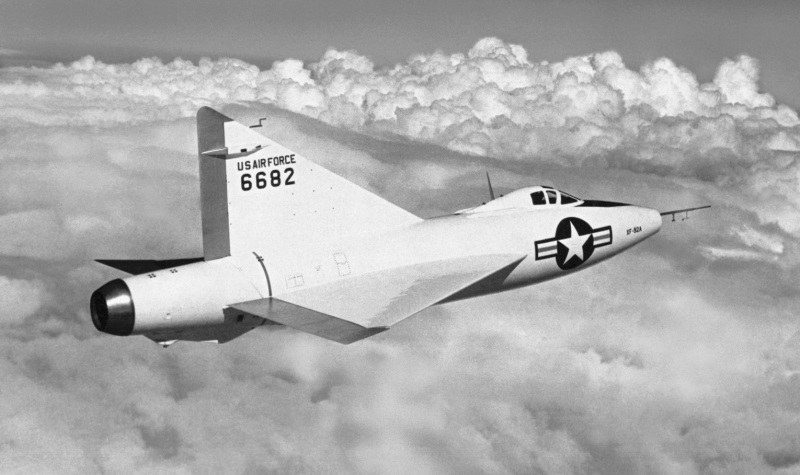
The Air Force gave the Model 7002 the service designation of "XF-92A". The first flight of the XF-92A, in natural metal finish, was on 8 June 1948, from what was then Muroc Dry Lake in California and with company test pilot Sam Shannon at the controls. After initial trials, the aircraft was refitted with an afterburning J33-A-29 turbojet, providing 33.4 kN (3,400 kgp / 7,500 lbf) thrust, with the new engine fit involving a fuselage stretch. The XF-92A was painted white and continued its sequence of flight tests at Edwards Air Force Base (AFB), as Muroc had been renamed in the meantime.
___________________________________________________________________
CONVAIR XF-92A:
___________________________________________________________________
wingspan:
9.53 meters (31 feet 3 inches)
wing area:
21.37 sq_meters (230 sq_feet)
length:
13 meters (42 feet 6 inches)
height:
5.38 meters (17 feet 8 inches)
empty weight:
3,855 kilograms (8,500 pounds)
MTO weight:
6,805 kilograms (15,000 pounds)
max speed at sea level:
950 KPH (590 MPH / 515 KT)
service ceiling:
14,020 meters (46,000 feet)
range:
580 kilometers (360 MI / 315 NMI)
___________________________________________________________________
The XF-92A was something of a disappointment, being both unreliable and performing well below expectations, which were admittedly inflated. It proved very useful, however, in correcting misperceptions and providing extensive data on the flight characteristics of delta-winged aircraft. After Air Force evaluation, the XF-92A was then handed over to the US National Advisory Committee on Aeronautics (NACA, the predecessor of the US National Aeronautics & Space Administration or NASA) for further flight tests into 1953.
BACK_TO_TOP* From the fall of 1948, the US Air Force had been considering development of an advanced supersonic interceptor, with a state-of-the-art fire control system (FCS) and armed with guided air-to-air missiles (AAM). The investigation congealed into a request to industry in January 1950 designated "Weapon System (WS) 201A". Eighteen companies responded, with Convair's design based on the delta-wing concepts explored with the XF-92A. In fact, initially the Convair design looked essentially like a scaled-up XF-92A, with a new fuselage forward of the wing featuring side-mounted engine inlets and radar in the nose.
In May 1950, six proposals were selected as semifinalists. The competition involved a contractor to develop the FCS -- the FCS being seen as the heart of WS-201A -- with Hughes obtaining the contract in June 1950. Three concepts for the aircraft component of WS-201A, designated "MX-1554", were selected for further development in July 1951, with Lockheed, Republic, and Convair making the cut. Lockheed dropped out, Republic didn't proceed beyond the mockup stage, and so Convair was selected to develop the "1954 Interceptor", as it was called, or "XF-102".
The actual prototype was the "YF-102", with two copies obtained for evaluation. The first YF-102 performed its initial flight from Edwards on 24 October 1953, with test pilot Richard L. Johnson at the controls. It had the delta wing and triangular tail arrangement of the XF-92A; tricycle landing gear, with the nose gear retracting forward and the main gear hinging in the wings in toward the fuselage. It was powered by a single Pratt & Whitney J57-P-11 axial-flow turbojet with 48.5 kN (4,945 kgp / 10,900 lbf) thrust. It had no cannon; it was to carry up to six Hughes Falcon AAMs as armament.
The first prototype was lost in a crash nine days after its first flight, after the engine flamed out during take-off, and the plane smacked back down on the runway. Johnson was badly injured; the aircraft was written off. The second YF-102 performed its initial flight on 11 January 1954, with Shannon at the controls. Unfortunately, all the flight tests showed was that the YF-102 was a dog, pure and simple, being badly underpowered and incapable of supersonic flight.
Convair engineers then went through a frantic and miraculous 117-day redesign exercise to come up with the "YF-102A", which did much to fix the problems. Four YF-102As were built, with the first flying on 20 December 1954, Richard Johnson performing the honors. The YF-102As featured a considerably more powerful J57-P-23 engine providing 53.4 kN (5,445 kgp / 12,000 lbf) thrust; a cambered wing; a redesigned canopy; and, importantly, an "area-ruled" fuselage. Area ruling had been invented by Richard T. Whitcomb of NACA, and improved transonic handling by ensuring that changes in aircraft cross-section were as gradual as possible, in effect giving airflow someplace to go. The F-102A's main concession to area ruling were prominent fairings on each side of the rear fuselage aft of the wings.
Development was further delayed by problems with the highly complex Hughes MG-3 FCS. The first production "F-102A" finally performed its initial flight on 24 June 1955 -- though in reality, the initial production aircraft were still evaluation machines, since the aircraft still didn't meet performance spec, and its high-tech subsystems were still going through the development mill. However, although there had been thought of canceling the program, Convair engineers were methodically, if painfully, converging on an aircraft that did what Air Force brass wanted it to do. In fact, as something of a vote of confidence in the F-102A, work was underway on a two-seat side-by-side trainer variant, the "TF-102A" -- sometimes mislabeled as "TF-102B" -- with Richard Johnson performing the first flight at Edwards on 31 October 1955.
The F-102A finally began to go into squadron service with the USAF Air Defense Command in April 1957. A total of 875 F-102s was built -- including the two YF-102s and four YF-102As -- along with 63 TF-102As. Some sources give the number of TF-102As as 111, but though that was the quantity ordered, the order was cut short before completion.
BACK_TO_TOPThe F-102A, or "Deuce" as the aircrews called it -- the formal name "Delta Dagger" was not used at the outset -- was mostly built of aircraft aluminum alloy, with some use of titanium. It had a low-mounted delta wing with a leading-edge sweep of 60 degrees, plus wing fences inboard and outboard, and two-section hydraulically-actuated "elevons" at the rear of each wing. Later production featured a "Case XX" wing with a slightly modified configuration relative to the "Case X" wing of initial production. The tailfin was triangular, with a hydraulically-actuated rudder; there was a distinctive set of hydraulically-actuated airbrakes behind and at the base of the tailfin. A brake parachute was housed between the airbrakes, and could be deployed when the airbrakes were open. Early production had a smaller tailfin.

The powerplant was a P&W J57-23A or J57-25 turbojet with 114.7 kN (5,305 kgp / 11,700 lbf) dry thrust, and 168.7 kN (7,800 kgp / 17,200 lbf) afterburning thrust. The engine was fed with inlets alongside the fuselage featuring splitter plates to reduce turbulent airflow hugging the fuselage -- the YF-102 lacked the splitter plates. There were four fuel tanks in the wings providing a total fuel capacity of 4,107 liters (1,085 US gallons). At least as originally designed, there were no provisions for external fuel tanks, since they would eat into aircraft performance.
The F-102A had tricycle landing gear, with all assemblies hydraulically actuated and all featuring single wheels. The main gear hinged in the wings toward the fuselage, with the nose gear retracting forward. There was no internal gun armament; primary armament consisted of six Hughes Falcon AAMs, two in each of three weapons bays in the belly. Initially, the F-102A carried three GAR-1 Falcons and three GAR-2 Falcons. The Falcons were carried on stub launch rails that were extended into the airstream for firing.
* The Falcon AAMs were a major component of the F-102A weapon system and deserve to be described in detail, but the story is a little confusing. The Falcon was a cylindrical missile with cruciform nose fins and long cruciform delta wings in the rear; it was powered by a solid-rocket motor. The GAR-1 used semi-active radar homing (SARH) guidance, meaning the F-102A kept the target "illuminated" with its radar and the AAM homed in on the radar reflections. The GAR-2 was almost identical, except that it used an infrared heat-seeker for guidance; a GAR-2A was soon introduced, being generally similar to the GAR-2, but with a better infrared seeker. A GAR-1 and GAR-2/2A were usually launched together to ensure a higher kill probability -- on the assumption that if one didn't work, the other one would.
A second-generation SARH GAR-1D was later introduced; while the first-generation Falcons had flight control surfaces at the end of the delta wings, the GAR-1D had separate control fins behind the wings, providing greater agility. It also featured an improved rocket motor.
No heat-seeking equivalent of the GAR-1D was built, because the Falcon family then quickly moved on to a third generation. The first of the third generation was the SARH GAR-3, which was slightly larger; had distinctive "strakes" forward of the delta wings; was powered by a still further improved rocket motor; and had improved seeker systems. The GAR-3 was only built in limited numbers, being quickly followed by the GAR-3A, with a better seeker and still further improved rocket motor. A similar heat-seeking GAR-4A was also built, as was a GAR-2B, with the first-generation Falcon configuration but the GAR-4A infrared seeker. It appears some GAR-2Bs were built new, but many were conversions of first-generation Falcons.
To make matters even more confusing, in 1962 the US military adopted a multiservice designation scheme, with all the Falcon designations changed in a non-intuitive fashion:
* In any case, the Falcons were complemented by 24 7-centimeter (2.75-inch) folding-fin air rockets (FFAR) carried in tubes built into the weapons bay doors. They were originally to carry 5-centimeter (2-inch) rockets, but the Air Force gave up on that weapon, standardizing on the FFAR. The Falcons were guided by a Hughes FCS, the early MG-3 being upgraded to the definitive MG-10. The F-102 was a very high-tech aircraft for its era and had a fairly high pilot workload. The pilot sat on an ejection seat under a clamshell canopy. Rear view was poor, but that was regarded as acceptable in an interceptor -- a hunter with no normal expectation of being hunted itself.
___________________________________________________________________
CONVAIR F-102A DELTA DAGGER:
___________________________________________________________________
wingspan:
11.62 meters (38 feet 2 inches)
wing area:
61.45 sq_meters (661.5 sq_feet)
length:
20.84 meters (68 feet 4 inches)
height:
6.46 meters (21 feet 2 inches)
empty weight:
9,145 kilograms (20,160 pounds)
MTO weight:
14,185 kilograms (31,275 pounds)
max speed at altitude:
1,330 KPH (825 MPH / 720 KT)
service ceiling:
15,550 meters (51,000 feet)
range:
2,175 kilometers (1,350 MI / 1,175 NMI)
___________________________________________________________________
The TF-102A had a revised forward fuselage with a side-by-side cockpit and considerably revised engine intakes. Not surprisingly, it was only marginally supersonic. The big canopy caused buffeting in trials, which was cured by fitting a set of untidy-looking vortex generators over its edges.

There was a consideration of an attack "F-102C" in the late 1950s, with two F-102s used as concept demonstrators, but the Air Force didn't buy the idea.
BACK_TO_TOP* Although some sources indicate the F-102A had a bad reputation, that was only to the extent that it took a fair amount of time to get it working right. Once it was, the F-102A proved to be a likeable aircraft, and it was the backbone of continental USAF Air Defense Command (ADC) for a time; as it was replaced by more modern aircraft in ADC service, it was gradually shifted to US Air National Guard (USANG) squadrons.

F-102s were provided with a series of upgrades in service:
The Deuce not only served in continental air defense, but also operated in Europe, Iceland, and South Korea. F-102As were deployed to Southeast Asia through most of the Vietnam War to provide protection against incursions south by North Vietnamese combat aircraft. Air bases in the theater were crowded with aircraft, and a sneak attack by North Vietnamese bombers would have been devastating, but such air attacks never actually took place.
Deuces were also used to escort B-52s on strikes over Laos or south of the demilitarized zone between North and South Vietnam. TF-102As were occasionally used as fast spotters, while F-102s were even used for night ground attack, using heat-seeking Falcons to hit enemy campfires, trucks, and other heat sources. Eventually, F-102s in the theater sported a neat and warlike disruptive camouflage paint job, replacing the standard ADC colors of light overall gray with a black nose. The camouflage paint job was also adopted for Deuces flying in Europe.
One Deuce was shot down during an escort mission over Laos by a North Vietnamese MiG-21 on 3 February 1968, the pilot, Lieutenant Wallace Wiggins, being killed. The F-102s scored no air-to-air kills themselves. 13 other F-102s were lost in the conflict, two being hit by ground fire; three destroyed on the ground by enemy sappers, plus one hit by a mortar round; and six were lost due to in-flight engine failures, along with one that suffered a ground collision.

The F-102A was phased out of operational service with the USANG in 1973. After their firstline service life, at least 65 and possibly 89 F-102As were converted to "PQM-102A" target drones by Sperry under the PAVE DEUCE program, with initial unpiloted flight in 1974. They were followed by 145 conversions to the "PQM-102B" target configuration, which had electronics in the nose instead of the cockpit to permit piloted flight. Some of the Deuce targets were actually "owned" by the US Army for surface-to-air missile (SAM) training. The PQM-102s were finally phased out in 1986.
* NASA flew the Deuce on a limited basis for trials and chase; the initial batch of NASA astronauts, the "Mercury 7", also used it to keep up flight hours for a time, though ultimately NASA would settle on the more economical Northrop T-38 Talon trainer as the astronaut mount. One F-102 was used by General Electric to test the J85 small turbojet, fitted to a centerline pylon.
About 35 F-102As and 8 TF-102As were supplied from USAF stocks to Turkey in 1968, with these aircraft serving to 1979. Two were reportedly shot down by the Greeks in air combat during the 1974 clash over Cyprus. 20 F-102As and 6 TF-102As were supplied from USAF stocks to Greece in 1969, with these machines serving to 1979. A good number of F-102s survive as static displays, but none are flying any longer.
BACK_TO_TOP* As mentioned, the F-102 went into service as an "interim interceptor", with Convair engineers continuing work on the "ultimate interceptor". They felt they could improve the F-102 considerably, focusing on a variant designated the "F-102B" that would have better performance and the advanced Hughes MA-1 fire-control system. The USAF placed an order for 17 F-102Bs in November 1955; however, the new variant was so different from the F-102A that it was given the entirely new designation of "F-106" in June 1956.
The first of two initial "F-106A" evaluation machines performed its initial flight at Edwards AFB on 26 December 1956, with Richard Johnson at the controls. It looked very much like the F-102A, close enough to allow someone not very familiar with aircraft to confuse the two -- but the YF-106A was a much cleaner design, and also featured a clipped-off tailfin, instead of the triangular tailfin of the F-102A. The actual area of the tailfin did not change. The F-106A used a bigger and badder derivative of the J57, the "J75", fed by new variable-ramp air intakes, with the more powerful engine providing a significant boost in performance. On 15 December 1959, USAF Major Joseph Rogers obtained a world speed record of 2,456.78 KPH (1,525.95 MPH) with the F-106A, and it is said that this remains the fastest flight ever of a single-engine jet aircraft.
The production F-106A "Delta Dart" reached initial operating capability with the ADC in October 1959, with the type becoming known as the "Six" to crews. A total of 277 F-106As was built, plus 63 "F-106B" tandem-seat operational conversion trainers, for a total of 340 in all. The USAF / USANG was the only operator.
* A general description of the F-106A almost exactly matches that of the F-102A. Like the Deuce, the Six was a delta-winged machine with a tailfin but no tailplanes, featuring tricycle landing gear, and a clamshell canopy that hinged open to the rear. Early wings had fences; later production featured slots instead. It was armed with four Falcon AAMs, plus a single MB-1 (later AIR-2) Genie unguided nuclear AAM -- intended for collision-course intercepts -- all missiles in belly weapons bays. There was no gun armament. The only external stores were external fuel tanks, one under each wing. The Six even retained the unusual tailfin airbrake (with drag chute) introduced on the F-102.
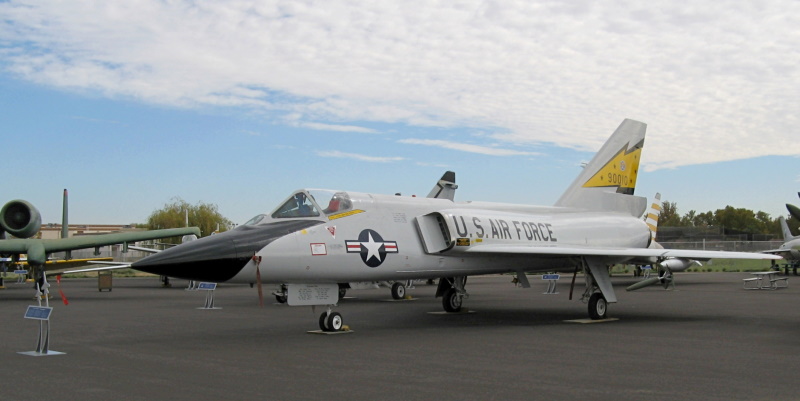
The Six was otherwise hardly a copy of the Deuce, with many refinements and detail differences -- in fact, the percentage of parts common between the F-102 and F-106 was small. Of course, there was the more powerful P&W J75 engine; the definitive J75-P-17 powerplant delivered 76.5 kN (7,800 kgp / 17,200 lbf) dry thrust and 109 kN (11,110 kgp / 24,500 lbf) afterburning thrust. The F-106A's fuselage was much more aerodynamically refined, in particular eliminating the tack-on fairings along the tail, and the improved MA-1 FCS provided SAGE compatibility from the outset. The steerable nosewheel had two wheels instead of one, and the external tanks were larger, each with a capacity of 1,364 liters (360 US gallons), as well as streamlined to permit supersonic carriage. A socket for midair boom refueling was added from 1967 as an upgrade.
The pilot sat on a Convair-designed ICESC (Industry Crew Escape System Committee) supersonic ejection seat, though it proved unsatisfactory, with some ejections resulting in fatalities. It was replaced by a Weber rocket-boosted "zero-zero" (zero speed zero altitude) seat from 1964. The Weber seat was not supersonic capable, but analysis of accidents showed that supersonic ejections almost never took place anyway -- usually when something went wrong in supersonic flight, the aircraft went subsonic immediately, or the anomaly was so disastrous that the pilot never had a chance to get out. The biggest hazards were actually in take-offs and landings.
___________________________________________________________________
CONVAIR (GENERAL DYNAMICS) F-106A DELTA DART:
___________________________________________________________________
wingspan:
11.67 meters (38 feet 4 inches)
wing area:
64.83 sq_meters (698 sq_feet)
length:
21.55 meters (70 feet 8 inches)
height:
6.18 meters (20 feet 4 inches)
empty weight:
10,800 kilograms (23,815 pounds)
MTO weight:
17,350 kilograms (38,250 pounds)
max speed at altitude:
2,395 KPH (1,490 MPH / 1,295 KT)
service ceiling:
17,680 meters (58,000 feet)
range with tanks:
3,140 kilometers (1,950 MI / 1,695 NMI)
___________________________________________________________________
The F-106B two-seater featured a one-piece clamshell canopy. The two-seater had the same length as the F-106A, with fuel tankage reduced and avionics rearranged to accommodate the second seat.
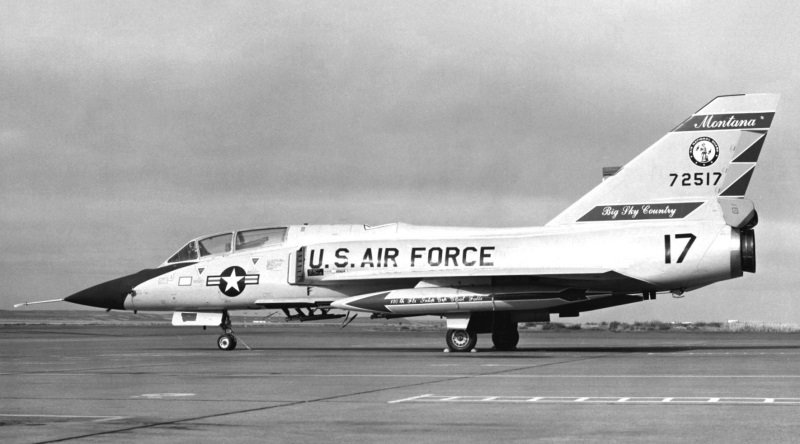
The F-106s primarily operated in the defense of the North American continent, flying from the continental US, Alaska, Canada, and Iceland, but were deployed temporarily on occasions to Germany and South Korea. They were not deployed to Southeast Asia, and Darts rarely flew in anything but standard ADC colors -- overall light gray with black nose, though squadron colors on the tailfin tended towards the flashy. Some very gaudy "red white & blue" paint schemes were sported by a few F-106s in 1976, in honor of the US bicentennial.
Upgrades were performed on a regular basis. Early upgrades were generally to fix aircraft teething problems, leading to additions such as a clear-view canopy; an airfield arresting hook; improved variable engine inlet ramps; retractable IRST unit; linear "tape"-style dashboard indicators that were easier to read than the original dial indicators; radar warning receiver; and improved solid-state electronics.
From 1967, F-106As were fitted with the General Electric M61A Vulcan 20-millimeter six-barreled Gatling cannon and gunsight under Project SIX SHOOTER -- the notion of arming an aircraft solely with AAMs having proven a little too ahead of its time. The cannon had an ammunition supply of 650 rounds and replaced the Genie AAM; arming the F-106 with a nuclear weapon proved troublesome because of the enhanced security and administration required. The F-106B received most of the upgrades as well, though no two-seater ever had the Vulcan cannon.
The Six was greatly admired by both service and aircrews alike, and in fact one of the reasons that the F-102 tends to be slighted in sources is because the F-106 was such a vast improvement on it. The F-106 was reliable, easy to maintain, and had outstanding performance. Although delta-winged aircraft tend to have long take-off runs because they can't usually be fitted with flaps, are hot on landing, and lose speed badly in turns, the F-106 had good handling and was said to be surprisingly agile, its high power-to-weight ratio allowing it to overcome a delta's limits on maneuverability. It had few "funnies", and gave plenty of stall warning. Pilots regarded it as along the lines of a "vintage automobile", with a profound taste of craftsmanship and class. It was phased out of ADC service in the early 1980s, to serve with the Air National Guard until 1988.
The F-106 never fired a shot in anger. The closest it came to doing so was on 14 May 1960, when a Martin Matador cruise missile "slipped the leash" of its radio control during a demonstration. An F-106A shot it down with two Falcons, neither of which had a live warhead. The Sixes also often "escorted" Soviet Tupolev Tu-95 "Bear" bombers along the US East Coast, the Tu-95s being on the way to Cuba or returning from Cuba, there never being any real trouble in these encounters.
Some sources claim the Dart was used for "dissimilar air combat training (DACT)" as an "aggressor" for some years because its performance was similar to that of a Soviet Mikoyan MiG-21 fighter. It appears that it was never actually used as a full-time aggressor, but participated in a number of COLLEGE DART exercises during the 1970s that involved DACT. There was some effort to sell the Six to the US Navy for DACT and models were made of the F-106A in disruptive desert camouflage for the role, but it didn't happen.
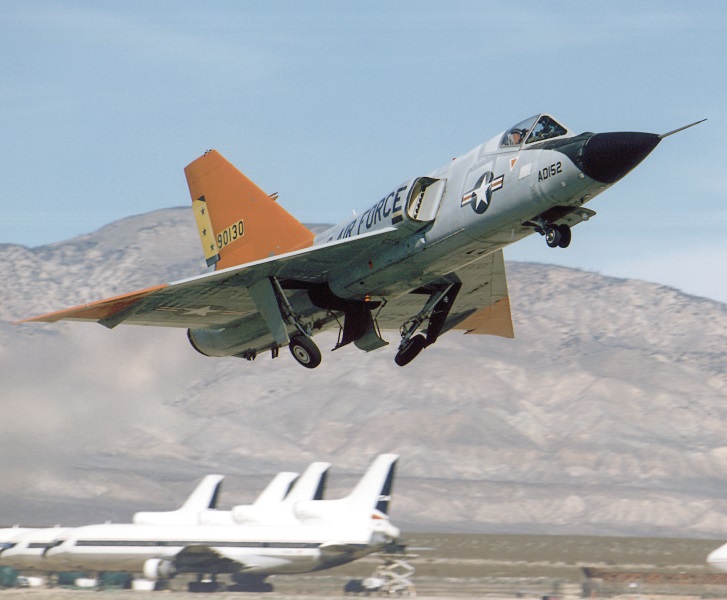
Almost 200 Darts were converted into high-speed target drones under the PACER SIX program, with the "QF-106" targets serving into 1997. Some F-106s were also used as high-speed chase planes, in particular supporting the Rockwell B-1 bomber project.
* As noted above, there were no foreign operators of the F-106. Convair did propose a multirole Dart with an attack capability to Japan, but the Japanese preferred the McDonnell F-4 Phantom. The F-106 was used in some trials work, one interesting configuration involving fit of a GE J85 turbojet under each wing, making this Six a three-engine machine. Another interesting trial involved carriage of the hefty US Navy Standard SAM on underwing pylons under the SEEKBAT program, with the Standard modified as a fast, long-range AAM to take on Soviet MiG-25 "Foxbat" reconnaissance aircraft.
NASA was another user of the F-106, employing it for trials from 1966 to 1998, with the type also being used as an astronaut mount for a brief period. One 1998 experiment under the Air Force / NASA Project ECLIPSE involved towing a QF-106A behind a Lockheed C-141 cargolifter, the QF-106A being fitted with a nose cable attachment. The program was intended to validate the concept of towing a reusable space launch vehicle to altitude for launch. There was a total of six towed flights in 1997 and 1998; the program was seen as successful, though nothing much came of it. This Dart was retired on 1 May 1998, and was said to be the last Six to fly. A number of F-106s survive as static displays. None are flying any more.
* Convair considered development of an improved "F-106C" (along with an "F-106D" two-seater) with a longer nose and more powerful radar. Two F-106As were modified to test F-106C radar, being designated "YF-106C", though it appears only one flew before the program was canceled.
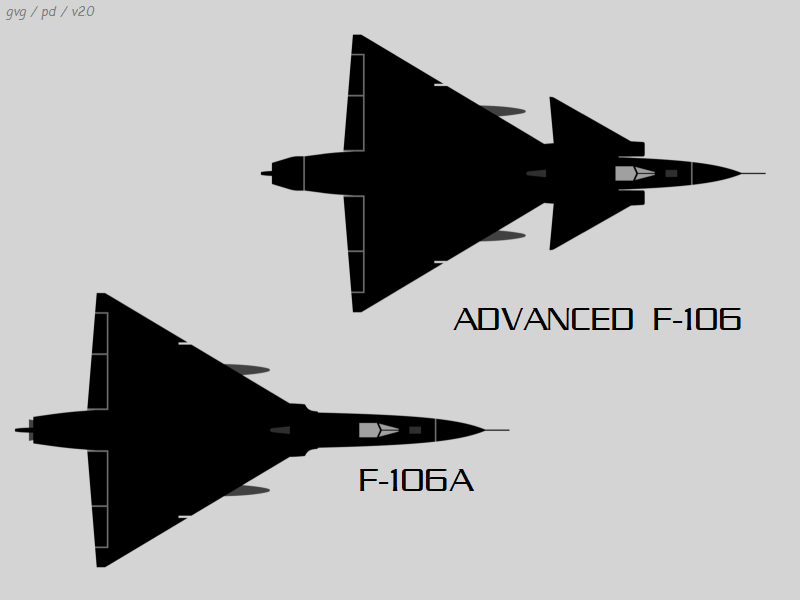
Convair also considered a bewildering range of F-106 follow-ons, the most ambitious featuring twin General Electric J93 turbojets, as used on the North American XB-70 Valkyrie experimental bomber, which would have given the F-106 Mach 3 performance. There was also consideration of an "Advanced F-106" with a single engine -- either a J75 derivative or alternative powerplant -- and fitted with canard fins. Both land-based and carrier-based versions were considered, the carrier-based version having folding wings. Of course, none of these F-106 follow-ons went beyond the model stage.
BACK_TO_TOP* In one of the more bizarre stories about the F-106 ... on 2 February 1970, four F-106As flew out of Malmstrom AFB, Montana, to "mix it up" among themselves as an air combat training exercise; one Dart had to abort when its drag chute opened before take-off. During the resulting sequence of dogfights, an F-106A piloted by First Lieutenant Gary Foust went into a flat spin at altitude -- and it wasn't easy to get the Dart out of a flat spin. Foust stayed with the machine, trying everything he could, but finally decided he was getting too low and ejected.
However, the ejection knocked the F-106 out of the spin, and it took off towards the horizon. Major Jim Lowe, who had been following Foust in one of the other two Darts and giving him suggestions, had to shout out: "Gary, you better get back in it!"
Of course, even though Montana contains a great deal of uninhabited land, it was worrisome to think about where the aircraft might come down. However, Foust had set the machine to take-off trim in one of his attempts to get it out of the spin, and take-off trim was similar to landing trim. It descended gradually and performed a very neat belly landing in a snow-covered field near the town of Big Sandy, missing a rockpile before it slid to a halt. A local law enforcement officer called Malmstrom and asked how to turn off its turbojet engine; he was told to just let it run out of fuel, which it did less than two hours later.
The F-106 had an ugly gash in its belly, but otherwise was structurally intact. The aircraft was disassembled, trucked to a railroad flatcar, and sent to California to be repaired and reassembled. It went back into operation, and in fact was one of the last Darts in ADC service. It is now on display at the USAF Museum at Wright-Patterson Air Force Base in Ohio.
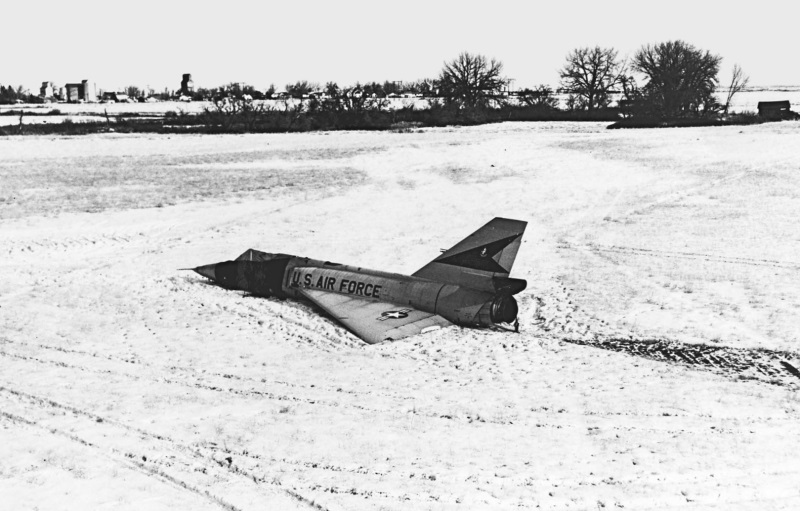
* Although much was made of the whizzy SAGE system, which supposedly could perform highly automated intercepts, pilots who flew the F-106 said it was highly unreliable, and they generally ended up performing intercepts under voice directions from ground controllers. SAGE was still often used, but it was on the basis of experimental evaluation, the belief being that the technology needed to be made right eventually.
One F-106 pilot commented later that he had heard Soviet aircrews were terrified of the Genie nuclear-tipped missile. He couldn't confirm that, but added that: "WE sure were!" The weapon never having been used in action, there were doubts that the launch platform could get out of the blast radius. No doubt if the pilots were told: "Don't worry about it!" -- such a display of complacency made them worry all the more.
I was very familiar with the F-106 when I was a kid in Spokane, Washington, since the USAF operated it from Geiger AFB there. I was a bit surprised later to find out that the "Geiger Tigers" were among the first to use the type in service.
* Sources include:
Online materials by aviation enthusiast Joe Baugher were also consulted.
* Illustrations details:
* Revision history:
v1.0.0 / 01 apr 08 v1.0.1 / 01 jun 09 / Added Gary Foust story. v1.0.2 / 01 may 11 / Added advanced F-106 variants. v1.0.3 / 01 apr 13 / Review & polish. v1.0.4 / 01 dec 13 / Review & polish. v1.0.5 / 01 nov 15 / Review & polish. v1.0.6 / 01 oct 17 / Review & polish. v1.0.7 / 01 sep 19 / Review & polish. v1.0.8 / 01 jul 21 / Review & polish. v1.0.9 / 01 jul 22 / Review & polish. v1.1.0 / 01 dec 23 / Review & polish. (+)BACK_TO_TOP
